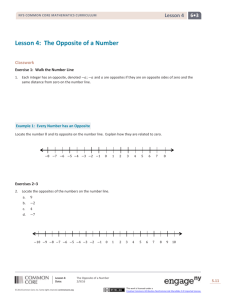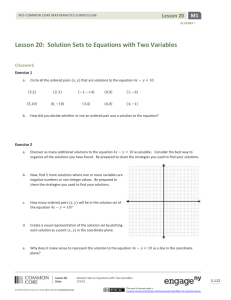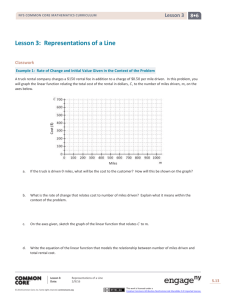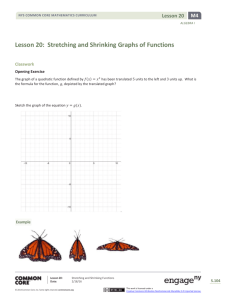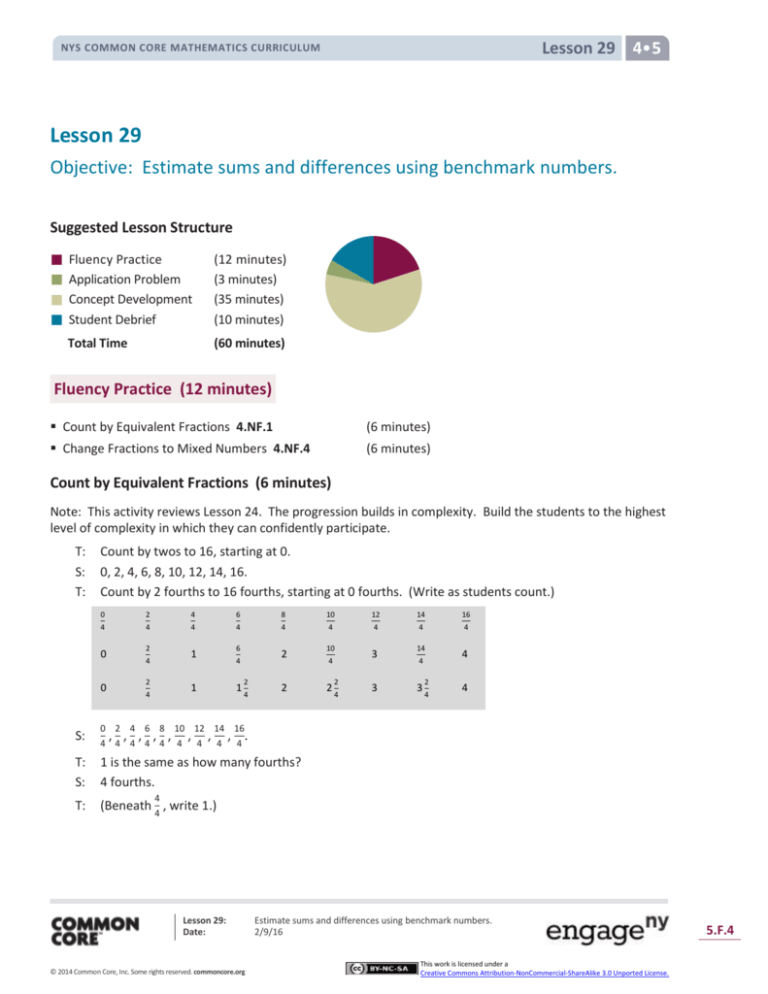
Lesson 29 4
NYS COMMON CORE MATHEMATICS CURRICULUM
Lesson 29
Objective: Estimate sums and differences using benchmark numbers.
Suggested Lesson Structure
Fluency Practice
Application Problem
Concept Development
Student Debrief
Total Time
(12 minutes)
(3 minutes)
(35 minutes)
(10 minutes)
(60 minutes)
Fluency Practice (12 minutes)
Count by Equivalent Fractions 4.NF.1
(6 minutes)
Change Fractions to Mixed Numbers 4.NF.4
(6 minutes)
Count by Equivalent Fractions (6 minutes)
Note: This activity reviews Lesson 24. The progression builds in complexity. Build the students to the highest
level of complexity in which they can confidently participate.
T:
S:
T:
Count by twos to 16, starting at 0.
0, 2, 4, 6, 8, 10, 12, 14, 16.
Count by 2 fourths to 16 fourths, starting at 0 fourths. (Write as students count.)
0
2
4
6
8
10
12
14
16
4
4
4
4
4
4
4
4
4
0
0
2
1
4
2
1
4
6
2
4
1
2
4
2
S:
0 2 4 6 8 10 12 14 16
, , , , , , , , .
4 4 4 4 4 4 4 4 4
T:
S:
1 is the same as how many fourths?
4 fourths.
T:
(Beneath 4 , write 1.)
10
4
2
2
4
3
3
14
4
3
2
4
4
4
4
Lesson 29:
Date:
© 2014 Common Core, Inc. Some rights reserved. commoncore.org
Estimate sums and differences using benchmark numbers.
2/9/16
This work is licensed under a
Creative Commons Attribution-NonCommercial-ShareAlike 3.0 Unported License.
5.F.4
Lesson 29 4
NYS COMMON CORE MATHEMATICS CURRICULUM
Continue the process for 2, 3, and 4.
T:
Count by 2 fourths again. This time, when you come to the whole numbers, say the ones. (Write as
students count.)
S:
0, 4, 1, 4, 2, 4 , 3, 4 , 4.
T:
(Point to 4.) Say 4 as a mixed number.
S:
1 4.
2
6
10
14
6
6
2
Continue the process for
10
4
14
and 4 .
T:
Count by 2 fourths again. This time, convert to whole numbers and mixed numbers. (Write as
students count.)
S:
0, 4, 1, 1 4, 2, 2 4, 3, 3 4, 4.
2
2
2
2
Change Fractions to Mixed Numbers (6 minutes)
Materials: (S) Personal white board
Note: This fluency activity reviews Lesson 24.
11
T:
(Write 6 .) Say the fraction.
S:
11 sixths.
T:
(Draw a number bond with
S:
6 sixths.
T:
(Write as a part. Write
S:
6
6
5
(Write 6
6
11
6
as the whole.) How many sixths are in 1?
as the other part.) Write the unknown part.
as the unknown part.)
6
T:
(Cross out 6 and write 1 beneath it. Write
S:
(Write
11
6
11
6
=____.) Write
11
6
as a mixed number.
5
= 1 6.)
Continue with the following possible sequence:
17 15
,
6 4
29
, and 8 .
Application Problem (3 minutes)
7
Both Allison and Jennifer jogged on Sunday. When asked about their distances, Allison said, “I ran 2 8 miles
3
1
this morning and 3 8 miles this afternoon. So, I ran a total of about 6 miles,” and Jennifer said, “I ran 3 10
3
4
miles this morning and 3 10 miles this evening. I ran a total of 6 10 miles.”
How do their answers differ? Discuss with your partner.
Lesson 29:
Date:
© 2014 Common Core, Inc. Some rights reserved. commoncore.org
Estimate sums and differences using benchmark numbers.
2/9/16
This work is licensed under a
Creative Commons Attribution-NonCommercial-ShareAlike 3.0 Unported License.
5.F.5
Lesson 29 4
NYS COMMON CORE MATHEMATICS CURRICULUM
Note: This Application Problem prepares students for today’s Concept Development by prompting them to
think about and discuss exact answers and estimates. Therefore, student conversations should include exact
and approximate reflections.
Concept Development (35 minutes)
Materials: (T) 4-inch piece of string (S) Personal white board
Problem 1: Estimate the sum or difference of two mixed numbers by rounding each fraction.
T:
S:
T:
T:
S:
What does it mean to estimate?
We don’t find the exact answer. We find numbers
at about the same value that are easier to work with.
We find an answer that is close but not exact. If
we estimate, it doesn’t have to be exact.
1
NOTES ON
MULTIPLE MEANS
OF REPRESENTATION:
8
Write 3 5 + 4 9. Let’s estimate the sum.
1
Round 3 5 . Think about benchmark numbers.
1
3 is close to 3. It’s a little bit more than 3.
5
It’s
more than 3. I round down to 3.
1
5
If necessary, present the visual of a
number line to support students
working below grade level as they
round mixed numbers.
8
T:
Round 4 9 .
S:
4 9 is close to 5. It’s a little less than 5. It’s 9 less than 5. I round up to 5.
T:
Quickly show 3 5 and 4 9 on a number line with endpoints at 3 and 5, only marking whole numbers
and the two addends.
(Construct and label a number line.)
Notice how close the mixed numbers are to the
rounded numbers. What is the estimated sum?
3 + 5 = 8. Eight is our estimate.
What if we were to estimate the difference?
S:
T:
S:
T:
8
1
1
8
Lesson 29:
Date:
© 2014 Common Core, Inc. Some rights reserved. commoncore.org
Estimate sums and differences using benchmark numbers.
2/9/16
This work is licensed under a
Creative Commons Attribution-NonCommercial-ShareAlike 3.0 Unported License.
5.F.6
Lesson 29 4
NYS COMMON CORE MATHEMATICS CURRICULUM
8
1
S:
We would still round to 3 and 5 and subtract 3 from 5. The difference of 4 9 and 3 5 is about 2.
T:
S:
Talk to your partner: Will the actual difference be a little more than 2 or a little less than 2?
A little less because you can see from the number line that the difference is greater when we
1
8
rounded. A little less because the number line shows that the distance between 3 5 and 4 9 is less
than 2.
Problem 2: Round two mixed numbers to the nearest half or whole number, and then find the sum.
9
4
9
T:
Write 8 10 + 2 8. What’s 8 10 rounded to the nearest one?
S:
9.
T:
How about 2 8 ? Do we need to round 2 8 ?
S:
No. 2 8 is the same as 2 2 . Can I keep it as 2 2 ?
T:
Yes. 9 + 2 2 is?
S:
It’s just 11 and then another half—11 2 . Well, I
can think of 9 on a number line, and then I can
picture adding two and a half more. Two more
1
1
makes 11. 11 + 2 = 11 2 .
T:
Why is your estimate greater than the actual sum? Talk to your partner.
S:
It’s greater because we rounded up 8 . We made it bigger. Our estimate is greater than the
4
4
4
1
1
1
1
9
10
4
actual amount because we rounded 9 tenths up to 1. We didn’t round 2 8 at all, but we did round
9
1
1
up 8 10 by 10 , so our actual answer will be 10 less than our estimate.
Problem 3: Estimate the difference of two fractions greater than 1.
MP.4
15
4
22
T:
Write
and 7 . What do you notice about these fractions?
S:
T:
They have different units. They are more than 1.
Go ahead and convert each to a mixed number.
S:
15
= (3
4
T:
Round 3 7 to the nearest one. Round 3 4 to the nearest one.
S:
T:
S:
T:
3. 4.
4 – 3?
1.
How else could you round to be more precise?
S:
I could round 3 4 to 3 2 and 3 7 to 3. The estimated
4
3
3
× 4) + 4 = 3 4 and
22
= (3
7
1
7
1
1
× 7) + 7 = 3 7 .
3
3
1
1
1
2
difference would be .
Lesson 29:
Date:
© 2014 Common Core, Inc. Some rights reserved. commoncore.org
Estimate sums and differences using benchmark numbers.
2/9/16
This work is licensed under a
Creative Commons Attribution-NonCommercial-ShareAlike 3.0 Unported License.
5.F.7
Lesson 29 4
NYS COMMON CORE MATHEMATICS CURRICULUM
MP.4
T:
Discuss with your partner. Which estimate is closer?
S:
One-half is closer. I know that because I took a little away from 3 4 to get 3 2 and a little away from
3
1
1
37
to get 3. Taking away a little from each means the difference is almost the same. I can see that on a
number line.
1
3
To verify that final statement (or to make it), take a string and stretch it from 3 7 to 3 4 on the number line.
Then, without adjusting its length at all, move it to the left to now match 3 and 3 and a half. The difference is
about the same.
Problem 4: Use benchmark numbers or mental math to estimate the sum and difference of two mixed
numbers.
7
3
T:
(Write 18 12 and 17 8 .) Estimate the sum using
benchmark numbers or mental math. Discuss your
strategy with a partner.
S:
18 12 is close to 18 2 , and 17 8 is close to 17 2 . I can add
the whole numbers first to get 35. 2 halves make 1.
7
1
3
1
T:
S:
1
NOTES ON
MULTIPLE MEANS
OF REPRESENTATION:
1
1
1
35 and 1 is 36. 18 + 17 = 35 + ( + ) = 36. The
2
2
2 2
sum is about 36.
Now, estimate the difference of the same two
numbers.
I can round to 19 and 17. But that’s rounding
up and down, which makes the estimated
difference bigger. Remember the example in the
1
last problem? I can just count up from 17 2 to
Scaffold finding the sum and difference
7
3
of 18 and 17 for students working
12
8
below grade level by chunking. First
isolate the fractions. Guide students to
7
find the benchmark closest to . Then,
12
reintroduce the whole numbers.
1
18 2, one. There are two halves between
them. Two halves make 1.
Problem Set (10 minutes)
Students should do their personal best to complete the
Problem Set within the allotted 10 minutes. For some
classes, it may be appropriate to modify the assignment by
specifying which problems they work on first. Some
problems do not specify a method for solving. Students
should solve these problems using the RDW approach
used for Application Problems.
Lesson 29:
Date:
© 2014 Common Core, Inc. Some rights reserved. commoncore.org
Estimate sums and differences using benchmark numbers.
2/9/16
This work is licensed under a
Creative Commons Attribution-NonCommercial-ShareAlike 3.0 Unported License.
5.F.8
Lesson 29 4
NYS COMMON CORE MATHEMATICS CURRICULUM
Student Debrief (10 minutes)
Lesson Objective: Estimate sums and differences using
benchmark numbers.
The Student Debrief is intended to invite reflection and
active processing of the total lesson experience.
Invite students to review their solutions for the Problem
Set. They should check work by comparing answers with a
partner before going over answers as a class. Look for
misconceptions or misunderstandings that can be
addressed in the Debrief. Guide students in a
conversation to debrief the Problem Set and process the
lesson.
Any combination of the questions below may be used to
lead the discussion.
In Problems 1(a) and 1(b), all fractions could be
rounded up or down by one unit fraction. Which
of the two estimates is closer to the actual
amount?
If one of the two fractions in Problem 1(a) was rounded down to half, the estimate would be more
accurate than rounding both to the nearest one. How do you decide which fraction rounds up and
which one rounds down?
Did your partner have the same estimates as you in Problem 2? Why or why not? Whose estimates
are closer to the actual answers?
Think about Problem 3. When would estimates need to be very close to the actual answer? When
might estimates be acceptable if the numbers were rounded to the closest whole number?
3
1
Some students estimated 45 or 44 4 for Problem 4(a). Some students estimated 9 or 9 2 for
Problem 4(c). Which answer for each problem is more reasonable? How does someone determine
how accurate the answer is?
What prior knowledge about fractions did you use as you completed the problems in the
Problem Set?
What tools did you use to help you estimate?
Exit Ticket (3 minutes)
After the Student Debrief, instruct students to complete the Exit Ticket. A review of their work will help with
assessing students’ understanding of the concepts that were presented in today’s lesson and planning more
effectively for future lessons. The questions may be read aloud to the students.
Lesson 29:
Date:
© 2014 Common Core, Inc. Some rights reserved. commoncore.org
Estimate sums and differences using benchmark numbers.
2/9/16
This work is licensed under a
Creative Commons Attribution-NonCommercial-ShareAlike 3.0 Unported License.
5.F.9
NYS COMMON CORE MATHEMATICS CURRICULUM
Name
Lesson 29 Problem Set 4•5
Date
1. Estimate each sum or difference to the nearest half or whole number by rounding. Explain your estimate
using words or a number line.
1
7
a. 2 12 + 1 8 ≈ ________
b. 1
11
12
3
4
+ 5 ≈ ________
7
8
1
9
1
1
3
1
c. 8 – 2
≈ ________
d. 6 8 – 2 12 ≈ ________
e. 3 8 + 5 9 ≈ ________
Lesson 29:
Date:
© 2014 Common Core, Inc. Some rights reserved. commoncore.org
Estimate sums and differences using benchmark numbers.
2/9/16
This work is licensed under a
Creative Commons Attribution-NonCommercial-ShareAlike 3.0 Unported License.
5.F.10
Lesson 29 Problem Set 4•5
NYS COMMON CORE MATHEMATICS CURRICULUM
2. Estimate each sum or difference to the nearest half or whole number by rounding. Explain your estimate
using words or a number line.
a.
16
5
+
11
4
≈ ________
b.
17
3
–
15
7
≈ ________
c.
59
10
+
26
10
≈ ________
5
8
1
3
1
2
3. Montoya’s estimate for 8 – 2 was 7. Julio’s estimate was 6 . Whose estimate do you think is closer to
the actual difference? Explain.
4. Use benchmark numbers or mental math to estimate the sum or difference.
3
5
11
4
5
c. 17 – 8
5
b. 3 12 + 54 8
a. 14 4 + 29 12
7
12
d.
Lesson 29:
Date:
© 2014 Common Core, Inc. Some rights reserved. commoncore.org
65
8
–
37
6
Estimate sums and differences using benchmark numbers.
2/9/16
This work is licensed under a
Creative Commons Attribution-NonCommercial-ShareAlike 3.0 Unported License.
5.F.11
NYS COMMON CORE MATHEMATICS CURRICULUM
Name
Lesson 29 Exit Ticket 4•5
Date
Estimate each sum or difference to the nearest half or whole number by rounding. Explain your estimate
using words or a number line.
9
1
1. 2 10 + 2 4 ≈ ________
8
9
2. 11 – 3
3
8
≈ ________
Lesson 29:
Date:
© 2014 Common Core, Inc. Some rights reserved. commoncore.org
Estimate sums and differences using benchmark numbers.
2/9/16
This work is licensed under a
Creative Commons Attribution-NonCommercial-ShareAlike 3.0 Unported License.
5.F.12
NYS COMMON CORE MATHEMATICS CURRICULUM
Name
Lesson 29 Homework 4•5
Date
1. Estimate each sum or difference to the nearest half or whole number by rounding. Explain your estimate
using words or a number line.
1
3
a. 3 10 + 1 4 ≈ ________
b. 2
9
10
+4
4
5
9
1
1
1
3
1
≈ ________
c. 9 10 – 5 5 ≈ ________
d. 4 9 – 1 10 ≈ ________
e. 6 12 + 5 9 ≈ ________
Lesson 29:
Date:
© 2014 Common Core, Inc. Some rights reserved. commoncore.org
Estimate sums and differences using benchmark numbers.
2/9/16
This work is licensed under a
Creative Commons Attribution-NonCommercial-ShareAlike 3.0 Unported License.
5.F.13
Lesson 29 Homework 4•5
NYS COMMON CORE MATHEMATICS CURRICULUM
2. Estimate each sum or difference to the nearest half or whole number by rounding. Explain your estimate
using words or a number line.
a.
16
3
+
17
8
≈ ________
b.
17
3
–
15
4
≈ ________
c.
57
8
+
26
8
≈ ________
5
8
1
2
1
2
3. Gina’s estimate for 7 – 2 was 5. Dominick’s estimate was 5 . Whose estimate do you think is closer to
the actual difference? Explain.
4. Use benchmark numbers or mental math to estimate the sum or difference.
3
11
9
11
7
a. 10 4 + 12 12
3
b. 2 10 + 23 8
c. 15 12 – 8 12
d.
Lesson 29:
Date:
© 2014 Common Core, Inc. Some rights reserved. commoncore.org
56
7
–
31
8
Estimate sums and differences using benchmark numbers.
2/9/16
This work is licensed under a
Creative Commons Attribution-NonCommercial-ShareAlike 3.0 Unported License.
5.F.14



